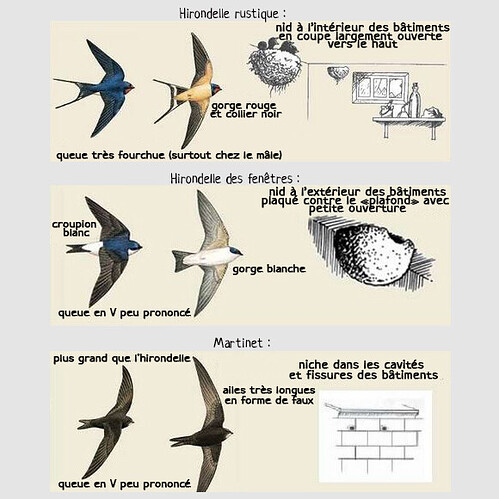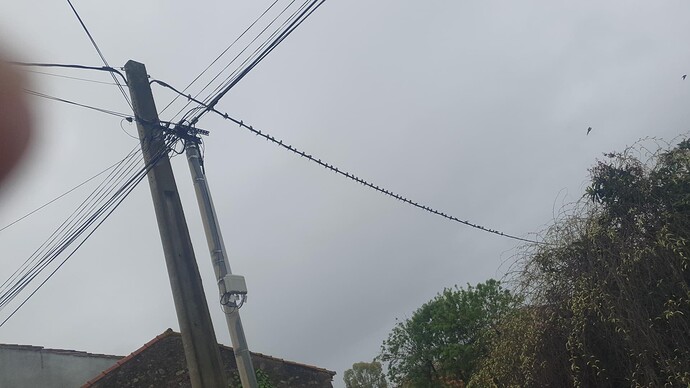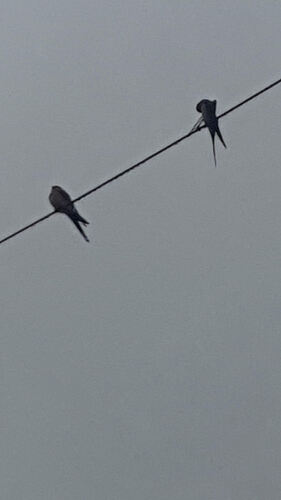here’s the link if you want to register to take part in the survey…
Talking of birds, I have had so many in the garden this week compared to previous weeks. All species and all collecting insects as it must be or near to be nesting time. The hoopoes have been noisy too, didn’t hear them until earlier this week but the lack of tramontine wind does make a difference.
I saw our first Hirondelle des fenêtres (House Martin) this morning and I shall be booking my place in the “survey” to be carried out later this year…
We lost these birds for a couple of years a while ago when all the cables went underground… then they decided to come back to their traditional nesting spots… hurrah.
Hoping to have Martinets (Swifts) back soon (last year was a first for us)
and, of course, the pucker Swallows (Hirondelle rustique) in the empty barn across the way as per every year.
Saw our first two swallows yesterday, just a pair flew over our heads very low from behind. No more sightings since then unfortunately. No swifts yet.
We don’t get swallows, but for the past few years I noticed an ongoing decline in the rock martins, but don’t know why because our valley is forest, not farmland so don’t know why there would be a decline in local the insect population (have noticed far fewer fireflies than a decade ago)
Shades of Silent Spring.…
Ours arrived this morning looking bedraggled and knackered as usual!
Housemartins arrived three weeks ago and a pair of Hoopoes last Saturday.
you are so lucky to still have overhead cables. The swallows love gathering on them… and since most of our cables went underground our swallows went off in a huff… ![]()
Hopefully they’ve stopped sulking at last… but only seen a couple so far…
It never twigged with me that burying the cables could make a big difference but when you think about it it will. In our commune, all the cables that were in the village proper have been buried over the last two or three years. It’s just the cables going down the road at the edge of the village (where we live) that remain above ground. We have seen a reduction in swifts and swallows here in the last few years.
Mind you, I have often wondered what birds did (swallows, house martins, starlings) BEFORE mankind put up telegraph wires.
I think mankind chopped down a lot of trees to make poles and create space for habitation, so trees are probably the answer. I suppose they adapted to use the wires as they are probably more convenient.
Power lines are more convenient… until a bush or tree growing below them gets tall enough that it’s so close to the power line that an earth connection can be made. At which point unfortunately the bird sitting on its regular power line gets a surprise ahem. And may well end up literally stuck there.
This is what happened at a spot opposite our driveway where I grew up. For years the power line was safe… and then it was not and there were a few birds that had got caught still attached to the wire. Corona and others will know about electricity arcing? etc but I gather the upgrowing bushes did not even have to grow as far as to touch the power line.
A tree branch will not earth a power line. First, the normal 220V power lines are insulated. The high voltage lines like the 13Kv line that goes not far from our house are not. Even then, the tree will not ground the line. The tree will also not conduct between those sort of power lines. Even if through some unlikely event it did ground the line or short the lines, any bird perched on that line would not be affected.
All I can say is there were 4 birds (dead) still attached hy their feet (3 upside down istr) to the line when I visited home, on the line that birds used as a favourite perching spot and safely flew off again in my.childhood.
The only difference was that the bushes under the line had grown and got much closer to the line, although still a decent gap.
When I asked I was told that within a certain distance power can “jump” and they got electrocuted.
I believe I also read the odd thing about something similar happenung to kids that climbed pylons - electrocuted without contact.
First swifts arrived last week in numbers similar to previous years - lots! Hoopoes still here, they normally leave after a couple of days and go into the vineyards.
Swifts still here, about double the numbers of last year which maybe accounts for the drop in numbers in UK. I don’t know where the swallows went to but they disappeared very shortly after their arrival. House martins still here in about the same numbers as last year and nest in the eaves of the houses in our Rue.


